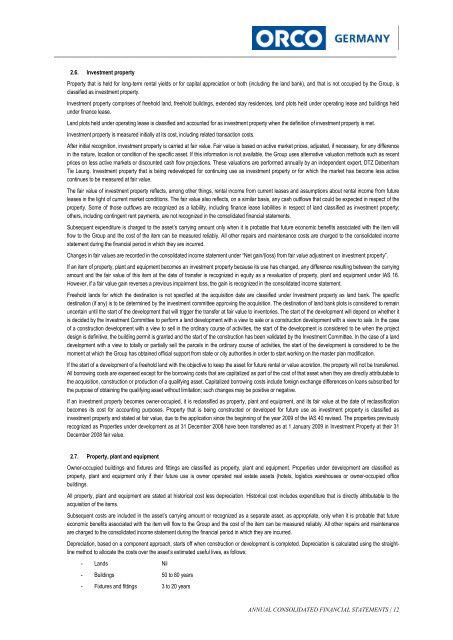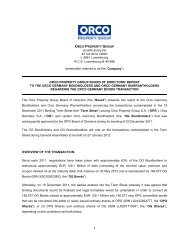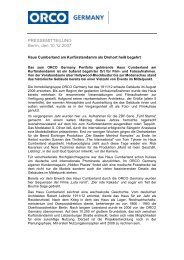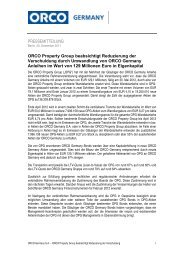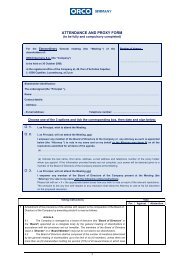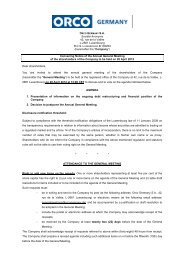Annual Report 2012 - ORCO Germany
Annual Report 2012 - ORCO Germany
Annual Report 2012 - ORCO Germany
Create successful ePaper yourself
Turn your PDF publications into a flip-book with our unique Google optimized e-Paper software.
___________________________________________________________________________<br />
2.6. Investment property<br />
Property that is held for long-term rental yields or for capital appreciation or both (including the land bank), and that is not occupied by the Group, is<br />
classified as investment property.<br />
Investment property comprises of freehold land, freehold buildings, extended stay residences, land plots held under operating lease and buildings held<br />
under finance lease.<br />
Land plots held under operating lease is classified and accounted for as investment property when the definition of investment property is met.<br />
Investment property is measured initially at its cost, including related transaction costs.<br />
After initial recognition, investment property is carried at fair value. Fair value is based on active market prices, adjusted, if necessary, for any difference<br />
in the nature, location or condition of the specific asset. If this information is not available, the Group uses alternative valuation methods such as recent<br />
prices on less active markets or discounted cash flow projections. These valuations are performed annually by an independent expert, DTZ Debenham<br />
Tie Leung. Investment property that is being redeveloped for continuing use as investment property or for which the market has become less active<br />
continues to be measured at fair value.<br />
The fair value of investment property reflects, among other things, rental income from current leases and assumptions about rental income from future<br />
leases in the light of current market conditions. The fair value also reflects, on a similar basis, any cash outflows that could be expected in respect of the<br />
property. Some of those outflows are recognized as a liability, including finance lease liabilities in respect of land classified as investment property;<br />
others, including contingent rent payments, are not recognized in the consolidated financial statements.<br />
Subsequent expenditure is charged to the asset’s carrying amount only when it is probable that future economic benefits associated with the item will<br />
flow to the Group and the cost of the item can be measured reliably. All other repairs and maintenance costs are charged to the consolidated income<br />
statement during the financial period in which they are incurred.<br />
Changes in fair values are recorded in the consolidated income statement under “Net gain/(loss) from fair value adjustment on investment property”.<br />
If an item of property, plant and equipment becomes an investment property because its use has changed, any difference resulting between the carrying<br />
amount and the fair value of this item at the date of transfer is recognized in equity as a revaluation of property, plant and equipment under IAS 16.<br />
However, if a fair value gain reverses a previous impairment loss, the gain is recognized in the consolidated income statement.<br />
Freehold lands for which the destination is not specified at the acquisition date are classified under Investment property as land bank. The specific<br />
destination (if any) is to be determined by the investment committee approving the acquisition. The destination of land bank plots is considered to remain<br />
uncertain until the start of the development that will trigger the transfer at fair value to inventories. The start of the development will depend on whether it<br />
is decided by the Investment Committee to perform a land development with a view to sale or a construction development with a view to sale. In the case<br />
of a construction development with a view to sell in the ordinary course of activities, the start of the development is considered to be when the project<br />
design is definitive, the building permit is granted and the start of the construction has been validated by the Investment Committee. In the case of a land<br />
development with a view to totally or partially sell the parcels in the ordinary course of activities, the start of the development is considered to be the<br />
moment at which the Group has obtained official support from state or city authorities in order to start working on the master plan modification.<br />
If the start of a development of a freehold land with the objective to keep the asset for future rental or value accretion, the property will not be transferred.<br />
All borrowing costs are expensed except for the borrowing costs that are capitalized as part of the cost of that asset when they are directly attributable to<br />
the acquisition, construction or production of a qualifying asset. Capitalized borrowing costs include foreign exchange differences on loans subscribed for<br />
the purpose of obtaining the qualifying asset without limitation; such changes may be positive or negative.<br />
If an investment property becomes owner-occupied, it is reclassified as property, plant and equipment, and its fair value at the date of reclassification<br />
becomes its cost for accounting purposes. Property that is being constructed or developed for future use as investment property is classified as<br />
investment property and stated at fair value, due to the application since the beginning of the year 2009 of the IAS 40 revised. The properties previously<br />
recognized as Properties under development as at 31 December 2008 have been transferred as at 1 January 2009 in Investment Property at their 31<br />
December 2008 fair value.<br />
2.7. Property, plant and equipment<br />
Owner-occupied buildings and fixtures and fittings are classified as property, plant and equipment. Properties under development are classified as<br />
property, plant and equipment only if their future use is owner operated real estate assets (hotels, logistics warehouses or owner-occupied office<br />
buildings.<br />
All property, plant and equipment are stated at historical cost less depreciation. Historical cost includes expenditure that is directly attributable to the<br />
acquisition of the items.<br />
Subsequent costs are included in the asset’s carrying amount or recognized as a separate asset, as appropriate, only when it is probable that future<br />
economic benefits associated with the item will flow to the Group and the cost of the item can be measured reliably. All other repairs and maintenance<br />
are charged to the consolidated income statement during the financial period in which they are incurred.<br />
Depreciation, based on a component approach, starts off when construction or development is completed. Depreciation is calculated using the straightline<br />
method to allocate the costs over the asset’s estimated useful lives, as follows:<br />
- Lands Nil<br />
- Buildings 50 to 80 years<br />
- Fixtures and fittings 3 to 20 years<br />
ANNUAL CONSOLIDATED FINANCIAL STATEMENTS | 12


